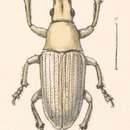Description
(
anglais
)
fourni par INOTAXA archive
♂. Oblong, robust, subfusiform, black, densely clothed with whitish or greenish-white scales, and also set with short, fine, decumbent hairs, those on the elytra uniseriately arranged down each interstice, the legs with longer hairs. Rostrum broadly excavate anteriorly; antennal scape strongly clavate, slender at the base, reaching to just beyond the eyes, the latter rounded and very prominent. Prothorax transverse, conical, the hind angles acutely directed outwards, the base moderately bisinuate. Scutellum small. Elytra broader than the prothorax, narrowing from the humeri, finely punctate-striate, the 2 II 2interstices almost flat, the minute piligerous punctures somewhat conspicuous. First ventral segment hollowed down the middle, the fifth slightly tumid in the centre posteriorly.
Length 7½—8½, breadth 2 5/6—3 1/5 millim.
- licence
- cc-by-3.0
- droit d’auteur
- Biologia Centrali-Americana
Distribution
(
anglais
)
fourni par INOTAXA archive
Hab.MEXICO, Acapulco (H. H. Smith).
- licence
- cc-by-3.0
- droit d’auteur
- Biologia Centrali-Americana
Physical description
(
anglais
)
fourni par INOTAXA archive
Two males, found in September, one showing the commencement of the change of colour in the scales—from whitish to green. Closely related to M. albicans, but with the scape of the antennæ slender at the base (and therefore strongly clavate), the elytra considerably wider than the prothorax and with a series of short, fine, decumbent hairs down each interstice. The slender base of the antennæ also separates M. brevipilis from M. fusiformis and the cinereo-squamose variety of M. splendidus.
- licence
- cc-by-3.0
- droit d’auteur
- Biologia Centrali-Americana

